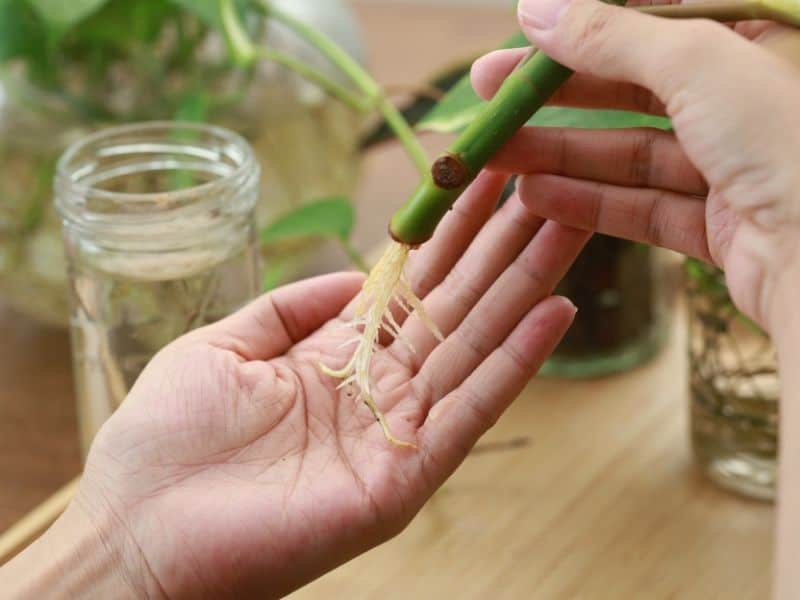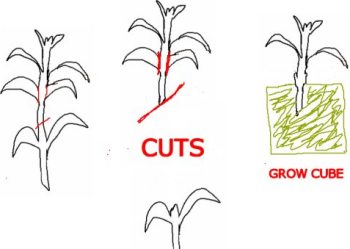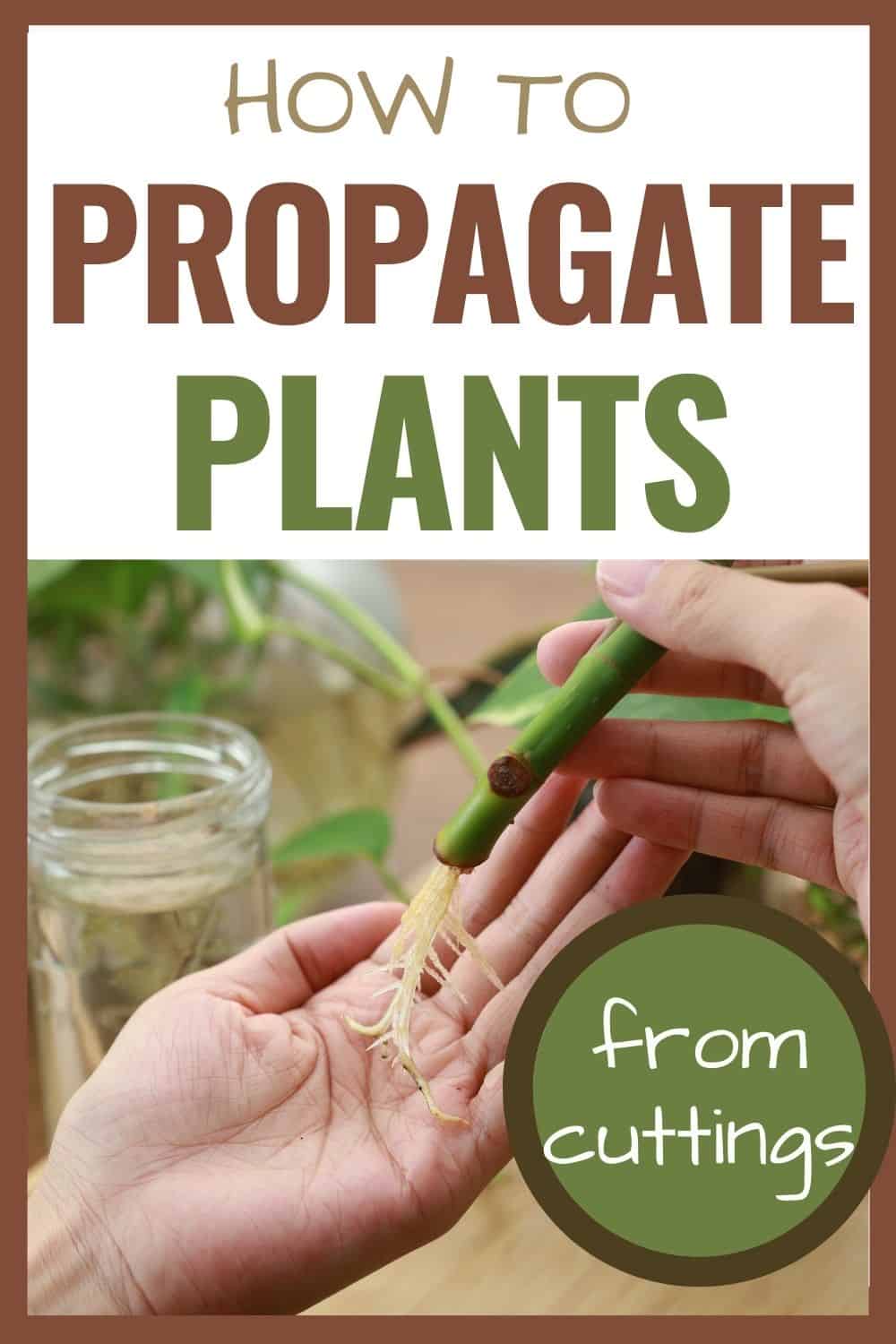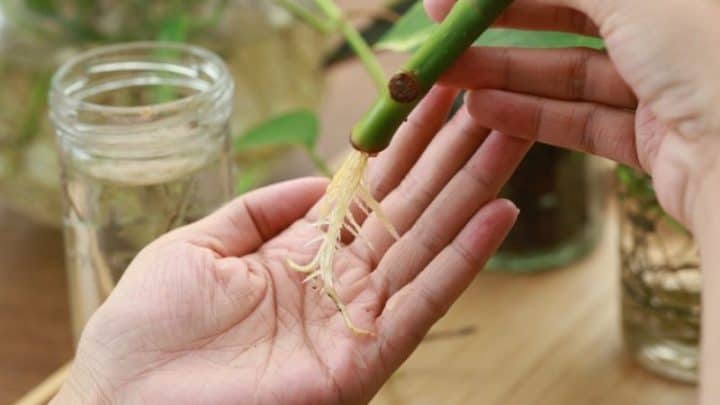Jumpstarting propagation by cutting and cloning might sound high-tech, but it’s not. When you were a kid, did you ever watch your mom take cuttings from a neighbor’s rose bush and “root it” for her own garden? Well, she was cloning it! Today, we’ll look at how to propagate plants from cuttings: it’s easy and rewarding!

So … cloning plants is taking a cutting from an adult female (momma plant) … forcing it to grow roots… and voila! New baby plant with the same genetic makeup (including sex) as the original plant.
Why wait for seeds to germinate when you can produce 6″ plants in a couple of weeks?
Using cuttings and cloning is a very good way to propagate new plants (for free) from an adult plant that has proven to have “good genes.” This method has been practiced for centuries: it is not futuristic, nor requires any scientific knowledge or specialized skills.
The Proper Climate for Cloning Plants
The most successful way to get a new cutting to sprout roots is to keep the upper part of the plant (the leaves) at the lowest metabolic rate possible. This encourages growth below, as the new baby has to “go and look for food” (by sprouting roots).
So, how do you create this “root-friendly” atmosphere? By providing weak food, low light, warm temperatures, and high humidity.
- If using GH Flora series for cloning, mix a one-gallon jug of water with ¼ teaspoon of each of the three solutions: micro, grow, and bloom.
- Dimmer and shorter light cycle: low-wattage fluorescent light (like a 20-40 watt under-counter lamp), on only 12 hours a day, 2” above the
plants. - Temperature: 78-80°
- Humidity: RH 90-100% the first week; then drop to 80-85%
- Food: use only water or Superthrive ‘til you see the first roots; then switch to ¼ strength nutrient solution.
Supplies for a good plant cloning program
HydroDynamics Clonex Rooting Gel Rockwool cubes
Rockwool cubes SUPERthrive VI30179 Plant Vitamin Solution
SUPERthrive VI30179 Plant Vitamin Solution
- Rooting hormone (Clonex gel is best, or use Olivia’s cloning gel)
- Optional: Superthrive (use instead of water for the first week or two, then switch to the weak nutrient solution mix)
- Grow plugs: use 1.5” Rockwool starter cubes
- Sharp razor blade or utility knife; dip in alcohol to sterilize it
- Optional but much easier: the perfect atmosphere is most easily achieved with an inexpensive domed nursery flat and warming mat.
- And the Cadillac Deluxe: Botanicare Power Cloner
A Perpetual Plant Factory
TIP: Keep the source plant (Momma) by itself in a bucket bubbler unit for 6-9 months before replacing it with a fresh mother plant. Click here for free bubbler plans.
You want to take cuttings only from healthy, mature (over two months old) female plants with “good genes”, which have not yet flowered. (Or if there are buds, strip them off). Don’t use plants that have been treated with pesticides or fungicides.
Momma plants can be kept strictly as a cloning source, are kept in a perpetual “growth” stage, and are not allowed to flower (by keeping them under MH lights for 18 hours per day).
This practice is popular with growers of ornamentals, kitchen, and medicinal herbs.
Here are some examples of plants that you can grow from cuttings.
How To Propagate Plants From Cuttings
First, prepare the starter plugs by dipping them in water, and enlarge the hole, if necessary, with a stick, nail, or utensil about the size of a chopstick.
Choose a good, fresh, vigorous growing tip for your clone, preferably from the lower branches, and then cut off the stem with your sterile razor, about 3-5” long, with 3-4 sets of leaves.
Next, trim the lower leaves until there are only 2 sets of leaves left). After that, you will shorten the cutting using the “Sip Of Life” technique.
The Sip of Life? Well, when you first take a cutting, a bubble of air can be drawn into the stem, preventing the solution from getting to the plant later (sorta like an “air embolism”). The plant will die if this happens.
So, how do you prevent air bubbles in the stem? Glad you asked: you will make a second cut under water. Place the cut end of the stem in a bowl of warm water, then take your clean razor knife and cut the stem about an inch up from the original cut at a 45° angle (under water).
Leave in the water until ready to plant. You want to end up with cuttings about 2-4” long, with only 2 sets of leaves (strip off the rest).

Keep the cuttings moist
- Next, take a cutting out of the water bowl, and immediately insert the cut stem into rooting gel, like Clonex for about 15 seconds. Then, place the stem 1/2” to 3/4” into the hole of a pre-moistened starter plug or cube.
Important tip: do not dip the stem directly into the original bottle of gel. Instead, pour a small amount into a shallow dish. Throw away any excess gel. Do not pour back into the bottle as you will contaminate it with organisms.
- Set the grow plug upright in your domed nursery, and provide optimum “rooting conditions” as described above. Keep the cubes evenly moist, but not soggy, and be sure to open the little vent holes in the dome for some fresh air.
- If you can manage it, mist the clones with clean water several times a day: this helps retard leaf metabolism and invigorates root growth. Get a cheap mister for a buck at Wal-Mart. (Don’t use one you’ve stored Windex in).
- After a week or so, remove the dome cover, but keep misting.
- The clones may actually wilt the first couple of days but should rebound from the shock. Do NOT PULL on the plant to determine if it is rooting. This will damage the new baby roots.
- After about 14-21 days, the clones will have grown a few inches and formed small but strong root systems, growing out the sides of the grow plug.
It’s time to place the clones, cube and all, into the hydroponic garden.







19 Easy Plants You Can Grow From Cuttings
Wednesday 13th of July 2022
[…] Growing new plants from cuttings feels almost magical. A stem of new growth placed in water or soil sprouts roots of its own and grows into a whole new plant. The process requires little effort and is so rewarding! I especially enjoy rooting cuttings of scented geraniums for my porch and pothos to trail down bookshelves. But you can also propagate shrubs, trees, and herbaceous garden plants from cuttings. However, some plants root more easily from cuttings than others, so it’s helpful to know which plants you can grow from cuttings and which ones need more coaxing or might not root at all. […]
Beautiful Flower Garden Ideas
Saturday 6th of March 2021
[…] How To Propagate Plants From Cuttings […]